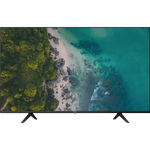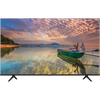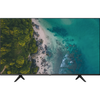A comparison of specs, key information, reviews, and best pricing from top retailers
Last updated -- hours ago | Report incorrect information
What we think

The PerfectRec TV team Learn more
Updated January 12, 2024·
If you're looking for a more budget-friendly option, the Hisense A6H could be a good choice, and it's excellent for mixed usage, though it may not offer the best experience in dark room viewing due to lower contrast. Both have similar capabilities for gaming and general TV watching but differ significantly in price and performance in dark versus bright environments. Give Feedback
this description is based on the product variant with some specs and product variant with some specs. At the time of writing, the variant with some specs cost some dollars and the variant with some specs cost some dollars.
Advantages of the Hisense A6H (LCD)
- The Hisense A6H (LCD) has no clear advantages over the Hisense U6G (LCD).
Advantages of the Hisense U6G (LCD)
- Good for bright room
- Good for dark room
- Good for movies & TV
- Very good for news, talk, & other TV
- Very good for cartoons & animation
Key differences
Picture Quality
5.7


7.7
4.74/10
CONTRAST
7.25/10
6.1/10
COLOR VOLUME SCORE
8.1/10
LED
PANEL TYPE
LED FALD
VA
PANEL SUB-TYPE
VA
The Hisense U6G (LCD) has good picture quality, while the Hisense A6H (LCD) has poor picture quality.
Movies & TV
5.4


7.6
4.74/10
CONTRAST
7.25/10
5.7/10
BLACK UNIFORMITY
7.7/10
7.5/10
UPSCALING
7.5/10
Yes
HDR10 SUPPORT
Yes
Yes
HDR10+ SUPPORT
Yes
Yes
DOLBY VISION SUPPORT
Yes
The Hisense U6G (LCD) is good for movies & TV, while the Hisense A6H (LCD) is poor.
The Hisense A6H struggles with movie and cinematic TV watching due to its lower contrast, lack of local dimming, and poor black uniformity, which are crucial for dark scenes details. In comparison, the Hisense U6G performs better with these types of content because it has higher contrast, effective local dimming, and excellent black uniformity, ensuring richer blacks and more depth in darker picture areas.
Gaming
5.8


6.8
6.5/10
RESPONSE TIME SCORE
7.8/10
10.0/10
INPUT LAG SCORE
10.0/10
2.5/10
MOTION PROCESSING
2.5/10
0.0/100
GAMING LOCAL DIMMING
70.0/100
5.4/10
GAME HDR BRIGHTNESS SCORE
7.2/10
The Hisense U6G (LCD) is only fair for gaming, while the Hisense A6H (LCD) is poor.
The Hisense A6H is rated lower in gaming due to its poor response time which affects how quickly it can display game actions, even though it has very low input lag which is good for responsiveness. In contrast, the Hisense U6G is considered better for gaming because it has a good response time, allowing for smoother motion in games, and also benefits from low input lag, making it more responsive to user inputs.
Cartoons & Animation
6.0


8.0
5.9/10
COLOR GAMUT SCORE
7.6/10
6.1/10
COLOR VOLUME SCORE
8.1/10
5.5/10
SDR BRIGHTNESS SCORE
8.4/10
8.3/10
COLORS OUT OF THE BOX SCORE
6.9/10
7.7/10
GRAY UNIFORMITY
7.2/10
The Hisense U6G (LCD) is very good for cartoons & animation, while the Hisense A6H (LCD) is only fair.
The Hisense A6H struggles with cartoons and animation mainly due to poor color gamut and below-average color volume, resulting in less vibrant colors. Meanwhile, the Hisense U6G performs very well as it offers a good color gamut and color volume, producing rich and accurate colors that enhance the viewing experience for animated content.
News, Talk, & Other TV
6.0


8.1
5.5/10
SDR BRIGHTNESS SCORE
8.4/10
7.5/10
UPSCALING
7.5/10
The Hisense U6G (LCD) is very good for news, talk, & other TV, while the Hisense A6H (LCD) is only fair.
The Hisense U6G excels in displaying news and talk shows as it features very good SDR brightness, enhancing visibility in bright rooms, and its superior contrast provides deeper blacks, important for overall picture quality. On the other hand, the Hisense A6H underperforms due to its poor SDR brightness and low contrast, which affects its ability to deliver sharp and clear images for typical TV programs.
Bright Room
5.5


7.3
6.5/10
VIEWING ANGLE
5.4/10
5.5/10
SDR BRIGHTNESS SCORE
8.4/10
5.3/10
HDR BRIGHTNESS SCORE
7.0/10
6.0/10
REFLECTIONS SCORE
6.3/10
The Hisense U6G (LCD) is good for bright room, while the Hisense A6H (LCD) is poor.
The Hisense A6H struggles in bright rooms because it has poor SDR and HDR brightness, which means it doesn't get very bright, and its reflection handling is only fair, resulting in a compromised viewing experience with ambient light. Conversely, the Hisense U6G is suitable for bright rooms since it has very good SDR brightness and good HDR brightness, which enable it to shine in well-lit environments, and despite having fair reflection handling like the A6H, its significantly enhanced brightness helps to mitigate glare.
Cost
$238


$398
$100
$200
$300
$400
$500
$600
The Hisense A6H (LCD) has a price of $238 and the Hisense U6G (LCD) costs $398.

Let Us Help Find Your Perfect TV
Find your new TV
Key similarities
Sports
6.1


6.1
2.5/10
MOTION PROCESSING
2.5/10
60Hz
REFRESH RATE
60Hz
10.0/10
INPUT LAG SCORE
10.0/10
7.5/10
UPSCALING
7.5/10
5.5/10
SDR BRIGHTNESS SCORE
8.4/10
Yes
HLG SUPPORT
Yes
The Hisense A6H (LCD) and Hisense U6G (LCD) are both only fair for sports.
The Hisense A6H has inferior motion processing and response time, leading to potential motion blur during fast-moving sports scenes, but offers better viewing angles that maintain image consistency when watched from the side. On the other hand, the Hisense U6G handles reflections better and has a good response time which is crucial for clarity in sports, but it has narrower viewing angles which could affect picture quality when not sitting directly in front of the TV.
Give feedback
We’re constantly working to improve.
How the Hisense A6H (LCD) and the Hisense U6G (LCD) compare to other TVs
Spec Comparison
| Hisense A6H (LCD) | Hisense U6G (LCD) |
GENERAL | |||
|---|---|---|---|
| Price | |||
$238 | $398 | ||
Brand | |||
Brand | Hisense | Hisense | |
Release Date | |||
Release Date | April 4, 2022 | May 1, 2021 | |
Full name | |||
Full name | 50A6H | 50U6G | |
Screen Size | |||
Screen Size | 50" | 50" | |
Screen Resolution | |||
Screen Resolution | 4K | 4K | |
TV FEATURES | |||
|---|---|---|---|
Operating System | |||
Operating System | Google TV | Android TV | |
Sound Quality Score | |||
Sound Quality Score | 5.9/10 | 6.9/10 | |
NextGen Ready | |||
NextGen Ready | No | No | |
HDMI Ports | |||
HDMI Ports | 3 | 4 | |
Coax Ports | |||
Coax Ports | 1 | 1 | |
DISPLAY QUALITY SCORES | |||
|---|---|---|---|
Picture Quality Score | |||
Picture Quality Score | 5.7/10 | 7.7/10 | |
Bright Room Score | |||
Bright Room Score | 5.6/10 | 7.3/10 | |
Gaming Score | |||
Gaming Score | 5.8/10 | 6.9/10 | |
Movies & TV Score | |||
Movies & TV Score | 5.4/10 | 7.7/10 | |
Sports Score | |||
Sports Score | 6.1/10 | 6.1/10 | |
PHYSICAL | |||
|---|---|---|---|
Dimensions w/o Stand (H x W x D) | |||
Dimensions w/o Stand (H x W x D) | 25.4" x 44" x 2.9" | 25.4" x 43.8" x 3.1" | |
Dimensions with Stand (H x W) | |||
Dimensions with Stand (H x W) | 27.9" x 44" | 27.8" x 43.8" | |
Weight without Stand | |||
Weight without Stand | 21.6 lbs | 27.8 lbs | |
VESA Mount | |||
VESA Mount | 200 x 300 | 300 x 200 | |
DISPLAY | |||
|---|---|---|---|
Color Depth | |||
Color Depth | 10 bit | 10 bit | |
Black Frame Insertion | |||
Black Frame Insertion | No | Yes | |
Auto Low Latency Mode | |||
Auto Low Latency Mode | Yes | Yes | |
Contrast | |||
Contrast | 4.7/10 | 7.3/10 | |
Local Dimming | |||
Local Dimming | 2.5/10 | 6.5/10 | |
SOUND | |||
|---|---|---|---|
Speaker Setup | |||
Speaker Setup | 2.0 | 2.0 | |
Speaker Power | |||
Speaker Power | 16 W | 20 W | |
Dolby Atmos | |||
Dolby Atmos | Yes | Yes | |
DTS:X | |||
DTS:X | Yes | Up to DTS Digital Surround, Bypass only | |
Get a great deal on the Hisense A6H (LCD) or the Hisense U6G (LCD)
About Hisense
Hisense, a Chinese TV manufacturer, entered the US market in approximately 2011 and has since acquired TV divisions from various companies such as Toshiba, Sharp, Hitachi, and NEC. Currently ranking as the fourth largest vendor in terms of sales volume, Hisense aims to capture a wide range of TV budget segments. They offer exceptional value with TVs that often outperform their competitors at similar price points, making them a compelling choice for consumers. In the US, they use Google TV as their smart TV software which provides the largest app selection and a very modern user interface, however it is not as user friendly as the software from other vendors.
Give feedback
We're constantly perfecting our model
TV guides you might be interested in
More comparisons for you
Compare Hisense A6H (LCD) vs. Vizio V-Series '22 (LCD)
VS
Compare Hisense A6H (LCD) vs. Insignia F30 2024 (LCD)
VS
Compare Hisense A6H (LCD) vs. Insignia F30 (LCD)
VS
Compare Hisense U6G (LCD) vs. Samsung CU8000 (LCD)
VS
Compare Hisense U6G (LCD) vs. Amazon Omni QLED (LCD)
VS
Compare Hisense U6G (LCD) vs. LG UR9000 (LCD)
VS
FAQs
FAQs about TVs
Why trust us
This information was produced and vetted by the PerfectRec TVs team. We are a product research and recommendation organization that meticulously reviews and evaluates the latest TV information and makes it digestible for you.
By the numbers
385
TVs evaluated
33,110
TVs stats compiled
21
Proprietary TVs ratings developed
121,830
Recommendations made
18,275
Consumer hours saved
About the TV team
Joe Golden, Ph.D
CEO and TVs Editor
Joe is an entrepreneur and lifelong electronics enthusiast with a Ph.D in Economics from the University of Michigan.
Jason Lew
Staff Expert & Software Engineer
Jason is a staff expert and software engineer that has been making laptop recommendations for 7 years and moderates one of the largest laptop subreddits.
Chandradeep Chowdhury
Staff Expert & Software Engineer
Chandradeep is a staff expert and software engineer and expert in televisions and monitors. He’s been making monitor recommendations for ten years.
Jaime Roldán
TVs Expert
Jaime is a Colombia-based TV expert. He is an electronics engineer with 8 years of experience in the telecom sector and has been making TV recommendations for 12 years.







